SilverStone RL06-Pro ATX Case Review
Pros
Cons
Rating
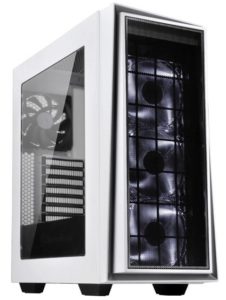
Introduction
Here at The Tech Buyer’s Guru, we really like reviewing cases. That’s why we’ve reviewed more PC cases than any other tech product. This is despite the fact that they are incredibly time-consuming to review, because a proper writeup requires that you actually build a PC in them (which oddly, a lot of reviews on the Internet don’t). And while big changes in other areas of PC technology get lots of press, the equally-important changes in case design often get overlooked, despite the fact that in the grand scheme of things, they might actually have a much greater impact on your user experience. This is doubly true if you intend to keep a case for a while, tweaking, refreshing, or completely rebuilding your PC over time, but sticking with the same chassis. That’s why every year, we aim to review the best new cases at a variety of pricepoints in order to give our readers a “best of” list that keeps up with the times. These top-rated cases end up being the driving force behind our Do-it-Yourself PC Buyer’s Guides, as they are the very first component readers will focus on as they select the right PC for their needs.
To keep up with all the latest designs, we spend a lot of time chatting with PC case vendors at trade shows each year (primarily CES and PAX West), which gives us a preview of all the “next big things” in PC cases long before they actually hit store shelves. And that’s how we came to review the subject of this article, the SilverStone RL06-Pro. SilverStone had a number of new cases on display at CES 2017, and right off the bat, this case was the one we thought had the greatest market potential, and therefore the one we most wanted to review. We’ve seen what it takes to make a case a #1 best seller. Back in 2015, we picked up the NZXT S340 as soon as it was released and published one of the first S340 reviews on the web. We called it a winner, more so for the forward-looking changes it brought to case design than for actual execution. And sure enough, today the S340 is the top-selling case in America in the coveted $50-$100 price bracket where most PC case buyers shop. Could the RL06-Pro unseat the S340 and thus become the next #1 best seller? Read on to find out!
We’d like to extend a special thank you to SilverStone for providing a review sample of the SilverStone RL06-Pro White Case.
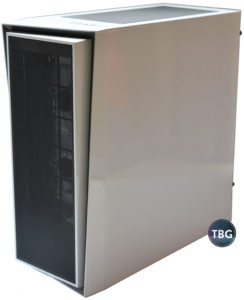
Description and Features
SilverStone markets the RL06-Pro as a high-performance case at a budget price. To achieve this performance, SilverStone starts with the basics: a main compartment devoid of drive bays, a fully-meshed front and top panel, and four 120mm fans, three mounted up front. Due to the compact layout of the RL06-Pro, those front fans are surprisingly close to the components they’re actually supposed to cool (i.e., the CPU and GPU), unlike in larger cases where front-mounted fans blow directly into closed drive bays, where the air is dissipated before it reaches gear that really needs the cooling. The case is 477mm tall and 455mm deep, quite tidy for an ATX case. Like many SilverStone cases, the RL06-Pro is also surprisingly narrow, at just 200mm wide. That gives it one of the smallest footprints of any ATX case, but also comes with its drawbacks, as we’ll discuss on the next page.
The RL06-Pro features top-mounted data ports on par with more expensive cases: two USB 3.0 ports and two USB 2.0 ports. Note that these are all of the Type-A variety, and we anticipate it will be a while before we start seeing Type-C ports on many cases, let alone lower-cost cases. SilverStone tried that approach with its RL05 case, but users took issue with the reduced number of Type-A ports this entailed, as Type-C is almost impossible to find being used by any peripherals or accessories today. The RL06-Pro has a nice-looking power button with an LED bezel, but oddly leaves out a reset button. This has been a trend in case design for the last couple of years, and we’re not sure how we feel about it. Yes, we understand that resetting a system can be done by a hard power-down in case of a crash, but it’s still a nice option to have, and probably wouldn’t add anything to the cost. The RL06-Pro does at least come equipped with a drive activity LED, along with headphone and microphone ports.
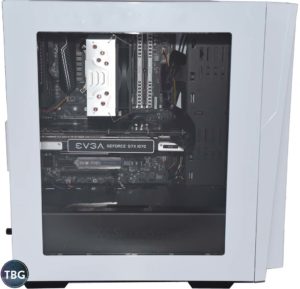
We’ll highlight some of the RL06-Pro’s other major features on the next page when we step through the assembly process, but first, let’s go over the components we used to put the case to the test:
- CPU: Intel Core i7-7700K
- Motherboard: MSI Z270 Gaming Pro Carbon (thank you to MSI for providing this review sample)
- Video Card: EVGA GeForce GTX 1070 SC 8GB
- SSD #1: Samsung 850 Evo 500GB M.2
- SSD #2: Crucial MX300 1TB 2.5″
- RAM: Corsair Vengeance 2x8GB DDR4-3000
- CPU Cooler: Arctic Freezer i32 (thank you to Arctic for providing this review sample)
- Power Supply: SilverStone Strider 850W Platinum (thank you to SilverStone for providing this review sample)
- Operating System: Windows 10 Flash Drive
This is in fact our brand-new mid/high-end benchmarking system, and we’ll be publishing a step-by-step assembly guide using these same components soon. SilverStone got lucky here, because there were a number of cases we were eyeing for this role, including the fantastic Phanteks Enthoo Pro M (a cost-reduced, higher-airflow version of the Phanteks Enthoo Evolv that we reviewed and loved), the sleek CoolerMaster MasterCase Pro 5, as well as some great new cases from Thermaltake (one of which we’ll likely be reviewing soon). We’ve also had discussions with Corsair about the cases they’ve announced over the past six months or so, but in reality, all of these cases (the Crystal 460X, the Crystal 570X, and the Air 740) have been delayed again and again, and in any event focus more on style than performance.
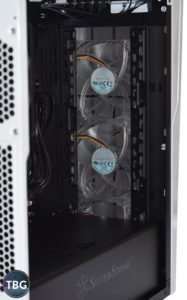
One thing that all of those cases have in common is that they cost more than the $70 RL06-Pro, which says something about the value proposition offered by the RL06-Pro. Yes, it’s smaller than those cases, which limits component selection somewhat, but in terms of style, features, and performance, it’s right on par with them. We’re pretty confident you won’t find another $70 case from any manufacturer than includes the RL06-Pro’s 10-port fan hub, four fans (let alone LED fans), along with high-quality craftmanship. We’ve provided a closeup interior view of the front fans to better illustrate their layout. Two drive air directly into the main compartment, while the lower fan sends most of its airflow through the bottom-mounted drive bay and PSU area.
Note that the chassis allows you to use either triple 120mm fans or dual 140mm fans, but it does not allow for customizing the location of these fans. The pre-drilled screw holes set those positions for you, and dual 140mm fans would be stacked at the bottom of the case, an unfortunate setup for cooling purposes. The triple-120mm array definitely makes the most sense in this case in terms of both cooling and exterior aesthetics. The LED lighting shining through the entire front fascia just looks great!
To help keep the interior clean despite the massive amount of air that will be flowing through it, the RL06-Pro includes filters for all of its intakes. A large, easily-removable mesh screen guards the front-mounted triple fan array, using a huge number of fine holes, which we find to be the most-effective, least-restrictive type of filter. It’s the same type of metal screen you’ll find on windows, and there’s a reason people use it in their homes – it keeps everything but the air out! The top vent (which can accommodate a 240mm radiator or dual 140mm fans) uses a very slick removable plastic filter held on by magnets. It’s easy to pull off, yet stays in place perfectly. Our only concern is that the plastic crimps easily, so if you don’t handle it gently, you might find it’s picked up a permanent crease, as ours did. Note that with top-mounted filters, the goal is really just to keep objects from falling in without blocking too much airflow, as the optimal thermal layout will always be to use this area for exhaust, not intakes. The bottom power supply intake uses a smaller plastic mesh filter, identical to the top filter, but much smaller. Like the top filter, it’s also removable (by sliding out), in case you don’t want to use it. We’d prefer to see a fine metal-mesh screen here, like the one used for the front fans, as these really do trap dust better than plastic filters.
All right, now that we’ve covered the basic description and features of the RL06-Pro, let’s get cracking on that build of ours to see how it works in practice!
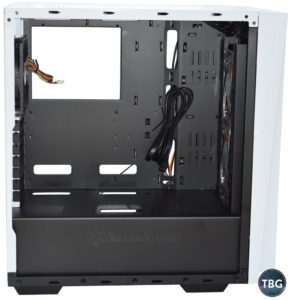
Assembly
As we made clear on the previous page, SilverStone has focused on top-notch airflow in the RL06-Pro, which we believe will beat any other case at its pricepoint. As can be seen in the interior shot shown here, the main motherboard compartment is as wide open as they come. Nothing’s going to stand in the way of air getting to your critical PC components! Cost-cutting had to be done somewhere, though, so you don’t get rubber grommets protecting the cable management cutouts, but at least you still get a stylish matte black interior finish. The only aesthetic letdown with this case are the un-sleeved fan leads, which contrast badly with the sleek paint job.
Of course, SilverStone is probably expecting you’ll use its 10-port fan hub tucked away behind the motherboard. It’s fantastic to find this piece of equipment in a case as inexpensive as the RL06-Pro, but given that it does not offer any fan controls, and instead runs directly off of a molex connector, it’s of limited use in our opinion. The front fans are rated at 1200RPM, but we found they spun all the way up to a very loud 1380RPM, a common issue with SilverStone fans. The company is very conservative when it comes to thermal issues, and it will always, and we do mean always, underrate its gear to make sure it meets the spec. The problem from our point of view is that faster fans aren’t always better, and the front fans are just too loud at nearly 1400RPM. Interestingly, the rear fan differs in more than just its lack of LEDs – it’s also a much slower fan, running at a maximum of 1000RPM. In our opinion, when you have a case with four fans in it, 1000RPM is all you really need from your fans, so perhaps SilverStone wants to be a little less cautious and load up the case with 1000RPM fans all the way around.
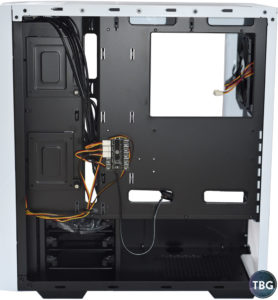
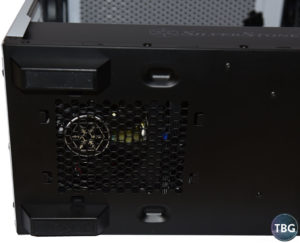
In the photo here, we show you what the power supply intake looks like. We’ve removed the mesh filter that we discussed on the previous page, which exposes a minor design problem. The ultra-compact SilverStone Strider 850W Platinum we used doesn’t line up correctly with the vent. Given that SilverStone is at the forefront of marketing short power supplies, we’re a bit surprised it didn’t take into account the fan location on these PSUs when designing its case.
Unfortunately, it’s not just SilverStone PSUs that will suffer a bit with this intake design; because of the large, rubber-coated feet, along with the divots that provide internal PSU support, the vent area is exceptionally narrow. We measured it at just 90mm wide, which is far from optimal given that most modern PSUs will be equipped with a 135mm or 140mm fan, and even compact models like our SilverStone Strider Platinum use 120mm fans. SilverStone should at least consider punching out more of the material in front of the feet to provide adequate ventilation to high-wattage PSUs, potentially redesigning the internal PSU supports as rubber fet, rather than metal divots punched up through the floor of the case.
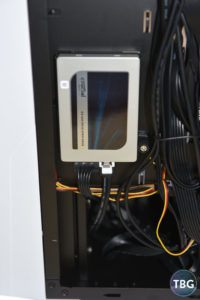
The trickiest thing about building a system in the RL06-Pro is its minimal amount of cable management space. In the closeup photo we’ve provided here, we show how getting our motherboard power cables, the front panel cables, and the SSD cables in place took a pretty concerted effort. To provide more space for cable bundles, we removed the three included 3.5″ hard drive trays, which we have no use for, as we no longer run mechanical drives in any of our systems. We’re glad that SilverStone has avoided crowding the main compartment of the case with 3.5″ drive bays, but it really needs to take into account that SATA cables aren’t all that pliable, and were never designed with ultra-thin 2.5″ laptop-style drives in mind. Therefore, flush-mounted SSD trays may seem like a good idea from an aesthetic point of view, but consideration really should be given to the thickness and orientation of the cables that must be connected to them. This isn’t a problem specific to SilverStone, however; in our NZXT S340 review, we pointed out that NZXT’s 2.5″ SSD trays made it impossible to cable the drives as intended.
Luckily, once the cables were corralled behind the motherboard tray, the rest of the system went together in just minutes. As with many SilverStone cases, only six motherboard stand-offs are pre-installed, so we affixed another three to accommodate our full-size ATX board, and then dropped the pre-assembled motherboard setup right in. We chose to install the CPU and cooler outside the case for better access, but given the large cutout behind the motherboard, this can easily be done with the motherboard inside the case as well. Note that SilverStone indicates that the RL06-Pro has 158mm of clearance for air coolers. Our 150mm-tall Arctic Freezer i32 therefore had no trouble at all fitting, but based on our measurements we know that coolers measuring 158mm tall will fit, and we believe 160mm-tall coolers may fit without touching the side panel. Again, SilverStone is playing the conservative card here in terms of specs to avoid disappointing its buyers. Whether larger coolers such as SilverStone’s 159mm-tall AR07 will indeed fit is something we’ll be testing in the near future when we conduct a mid-range CPU Cooler Shootout in this case.
Performance
We chose to connect each of the RL06-Pro’s fans to a separate fan header on our test motherboard, which had an ample six headers. If you’re using a motherboard with insufficient fan headers, or if you just want an easier fan management setup, you can buy SilverStone’s CPF02 three-way splitter to connect all three front fans to a single motherboard header. We think this is far preferable to using the RL06-Pro’s fan hub, and we’d actually recommend that in future case revisions, SilverStone include this splitter instead of a hub. We bet it would actually reduce costs, while potentially increasing utility. Once we had our fans dialed in with our motherboard’s fan management utility, and we had our Core i7-7700K properly overclocked (to 5GHz, naturally!), we were ready to test out the RL06-Pro’s performance metrics.
In the photo below, you can see our test system powered on and ready to rock, placed right next to its best-selling rival, the NZXT S340. Eagle-eyed readers will notice that to really put the RL06-Pro to the test, we dropped in an extra little component we had on hand. Try to spot it, and we’ll come back to how the RL06-Pro handled it in a moment! Note that unlike other publications, we don’t provide case performance metrics with identical gear. While that approach has merit, it means you’ll see brand-new cases outfitted with sometimes decade-old gear to keep testing consistent. We’d rather show you how a case performs with gear you’d use with it today. So with that in mind, we’re going to give you our subjective opinions on how the RL06-Pro performs both in the abstract, and against the NZXT S340, despite testing them with different generations of gear.
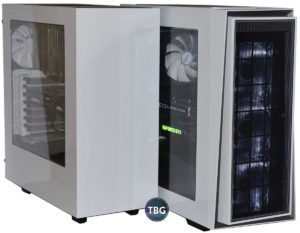
As can be seen, these cases are nearly identical in size, and they’re almost identical in layout as well. The RL06-Pro is a few millimeters taller, 20mm deeper, and a few millimeters narrower. All told, if one case would work for your desk area, it’s almost certain the other will as well. The big difference between the two cases is in aesthetics and airflow. As can be seen, the S340 uses a solid front panel, which forces all airflow to come through narrow slits at the top and bottom. Ironically, from the factory, NZXT doesn’t even install a front fan, instead placing the two 120mm fans in the rear and up top (in the 140mm fan mount, where it does little more than create ample amounts of noise). This setup is going to generate very little airflow, so the limited intake area isn’t of much consequence. What all this means is that the S340 simply cannot support high-end setups, unlike the RL06-Pro. In terms of noise, we found that the two cases were very similar, at least when we ramped down the RPMs on the RL06-Pro’s front fans using motherboard controls. That allows it to match the S340’s noise levels, while providing far-superior airflow.
Beauty is in the eye of the beholder, but we’ve come to view the S340 as looking a bit too much like a mini-refrigerator, and find the RL06-Pro’s more aggressive appearance, including its meshed front fascia, both functional and attractive. While some may chafe at the LEDs, SilverStone will eventually be shipping an RL06 in non-Pro form, with just a single rear 120mm fan. That would allow you to choose your own unlighted fans to fill the front fan slots. Another subtle difference between the two cases, and one that reflects that changing approach to case design in the past few years, is that the RL06-Pro’s window extends much further down, which we think gives it a much more symmetric look than the S340’s window. When cases with side windows first hit the market, manufacturers were very cautious about how much of the interior they would expose, and the S340’s window was designed to cover the PSU shroud, but ends up making the case look off-balance.
We subjected the RL06 system to intense stress, running Intel Burn Test, an AVX-based load generator, with our CPU clocked at 5GHz using 1.35V. The CPU topped out at 98 °C, which is hot, but not hot enough to trigger thermal throttling. In a lesser case, this wouldn’t have been possible, especially not with the highly-effective but budget-oriented Arctic Freezer i32 cooler we used. And note, there is no application you can run that would possibly stress the system this much. In our gaming test, playing the new For Honor beta, our massively-overclocked CPU hovered around 60 °C most of the time, topping out at 76 °C for a brief moment, and our GPUs (yes, we did say GPUs, folks!) ran at an ultra-cool 70-72 °C. That’s far cooler, for example, than they ran in our Phanteks Enthoo Evolv case, which costs over twice as much. Admittedly, it has much finer materials, but from a performance perspective, the RL06-Pro is an unbeatable value. We wouldn’t even bother trying this setup in a stock S340, by the way. We slipped the extra GPU in because we knew the RL06-Pro could handle it, not because we think that any other $70 case could.
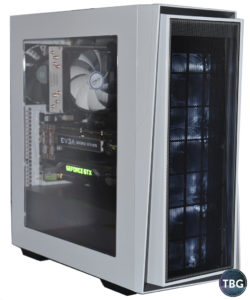
Conclusion
There’s just no other way to say this: the RL06-Pro is the best enthusiast-class case you’re going to find at its pricepoint. The well-designed interior layout works hand-in-hand with the four supplied 120mm fans to provide tremendous airflow, and with space for two large video cards, as well as powerful 120mm-type CPU coolers (or liquid radiators), you can really run some seriously-high-end gear in this case. Now, it does have some stiff competition from a couple of cases, namely the Corsair Carbide 100R Silent Edition at the lower-end, and the Phanteks P400 and aforementioned NZXT S340 on the upper-end of its price bracket, but all of these cases are focused more on quiet operation and buttoned-down aesthetics than all-out performance. The RL06-Pro sports twice as many fans, plus a fully-meshed front panel to allow your PC to work to its potential. We’d also argue that a well-tuned open-mesh case can run as quietly, or potentially even quieter, than “silent” cases, which often need to run their internal fans at much higher RPMs to achieve the same cooling levels.
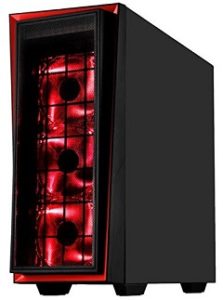
Of course, the RL06-Pro isn’t perfect, but no product ever is. We wish it had about 1cm extra clearance behind the motherboard for cable routing, a better-designed PSU air intake, as well as a fan hub that allows for fan speed control, or alternatively a PWM splitter. As it is, use of the hub will lead to more noise than necessary to keep just about any components cool, but we understand that sophisticated fan control isn’t going to be possible at this pricepoint. In the end, though, these issues are easy enough to work around, and aren’t all that different from issues we’ve seen in cases costing twice as much as the RL06.
As of our publication date, the SilverStone RL06-Pro White (with white LEDs) is available for $69.99 shipped free from Amazon, as is the RL06-Pro Black (with Red LEDs). Pick your color and you’re ready to go, because you won’t find a better case anywhere near this price! If you’d like to build your own PC using the RL06-Pro check out our $1,250 Gaming PC Buyer’s Guide, where it will work perfectly!

